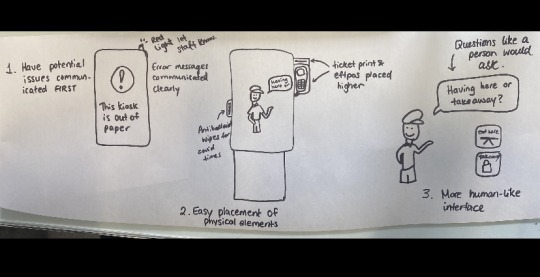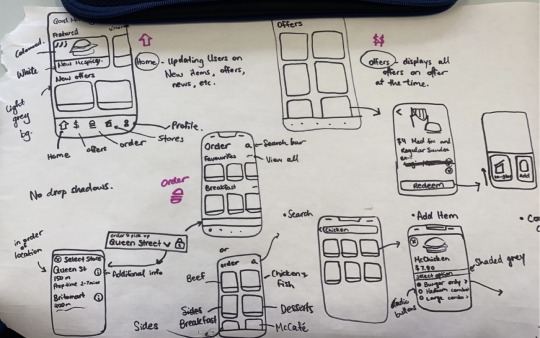Text
User Research Review
My initial target user of less tech savvy (mostly older) users was given up on in week 9 due to proposed improvements being rendered useless. However, time was not wasted as now I know that I must do what I can. The project went from Self serve kiosks to the mobile app. This now allows me to target a wider user base and implement new mobile ordering system.
0 notes
Photo

Deciding what to improve/implement
1. communicating errors within system (e.g kiosk out of paper) to user and workers
2. physical touchpoints placed more ergonomically
3. more human-like interface with virtual assistant who asks questions much like how a real worker will
0 notes
Text
process mural
https://app.mural.co/invitation/mural/xrp96117444/1648502924918?sender=u6971c93e5718812e733e6459&key=103931ae-99d2-4112-8cf6-5107e23affd9
0 notes
Text
Possible research methods - Mature adults and self serve kiosks (SSK)
Qualitative Surveys (Problem framing)
1. Learning about general attitudes - if given the choice, would you rather order with a person? would you use a kiosk to bypass a long queue? if there were someone to help you, would you try it? have you used any other sort of kiosk before? e.g at a mall or in the museum/library? if yes, what's better about that? is there an appetite?
2. What are the specific problems people are having - 'what do you find most frustrating or difficult/embarrassing/confusing?' 'What can be added or improved to make your experience better?'
User testing
Gathering as many Generation X or older people (most importantly retired elderly) as possible and observing/recording their interaction with a McDonalds SSK, from beginning of the order to payment.
Giving them different tasks, e.g Put through an order for a medium Big Mac combo/order a cheeseburger with no mustard/order what you usually get
-> User interviews
Finding specific pain points of the kiosk. 'what did you find most frustrating or difficult/embarrassing/confusing?'
Competitor analysis
Seeing how other fast-food restaurants have their SSKs.
Existing research
Find research articles on elderly and SSKs.
Find other user-observations e.g on YouTube.
A/B Testing
Test potential improvements from original product feedback and benchmark to see if there was significant change.
0 notes
Text
Some things to think about
Large text and high contrast levels
Increased feedback to minimise demands on working memory and to clarify user action sequence - inform user of where they are in the system and where they have been
0 notes
Photo

Assumptions on Self-serve kiosks and elderly people
Upon assessing assumptions and facts/personal anecdotes, there are two main factors as to why the elderly struggle to use kiosks.
1. Physiological
a. Compromised eyesight - key buttons and text/information missed. can't find eftpos machine at bottom
b. Difficulty reaching certain places e.g down low for an eftpos machine (McDonalds) or bag tag (Air NZ kiosk)
c. Struggle to stand for prolonged periods
2. Socio/Environmental
a. Loneliness - they miss talking to someone as they have seen the world change from local butchers and small community culture.
b. Some elderly people (dependant on computer exposure, when retired, etc.) aren't computer natives and cannot understand basic UI metaphors like shopping cart icon, scrolling and other touchscreen gestures. User action sequences are unclear and difficult to grasp.
c. Pressured to keep up with change, therefor more likely to be afraid of making mistakes (scared to ‘break’ the machine by pressing something wrong and not being able to correct it) pressure to move quickly, which increases stress and furthers digital exclusion
0 notes
Text
Modern NDIR sensor
8 mm x 33 mm x 20 mm footprint
Typically consumes 50 to 200mW. Low power consumption makes new generation of NDIR CO2 sensors capable of running for months on battery or solar power alone
This device below adopts the NDIR sensor

0 notes
Text
Types of CO2 sensors
1. Non-Dispersive Infrared (NDIR) Sensor
Uses specific wavelengths of light to measure the amount of CO2 in the air
Pros - long lasting (up to 10 years), other substances will not interfere with readings,
Cons - can be affected by humidity and temperature
2. Electrochemical Sensors
Measures electrical current or conductivity to determine how much CO2 is present in the air
Pros - Less susceptible to humidity and temperature changes than NDIR or MOS sensors
Cons - Other substances can throw off readings, does not last as long as NDIR sensors, the sensor can “drift,” or lose accuracy
3. Metal Oxide Semiconductor (MOS) Sensors
Uses the resistivity of metal compounds to test the amounts of gas in the air.
Pros - simple design makes them easy to use
Cons - Can be affected by temperature and humidity, other substances in the air can throw off readings
Conclusion - NDIR
NDIR sensor will be best, as it can provide information at lower CO2 levels, below 1000ppm, which is much more helpful in a CO2 monitor for the home. They also last the longest out of the three sensors.
It also has no cross-sensitivity. Both MOS and electrochemical sensors can have something called cross-sensitivity bias. When a substance other than CO2 reacts in the sensor, it changes the electrical properties of the sensor and the readings it gives you. NDIR sensors do not have this problem, as only CO2 can absorb the light emitted in the sensor.
NDIR has no drift, which occurs in the other two types of sensors when they eventually lose electrons.
Although the sensor can be affected by humidity and temperature, this can be combatted by placing the sensor away from kitchens/bathrooms and in more neutral spaces in the home such as lounges or bedrooms.
All above information sourced from kaiterra.com
0 notes
Text
Game/Reward system
Game - challenging friends to see who can have the lowest co2 output of the week
Reward - collaboration with carbon friendly companies / those with products that make an eco-friendly lifestyle easier e.g Allbirds carbon neutral shoe discount codes, Hellofresh vegetarian/vegan meal plan vouchers [below]


[above] Allbirds shoe company preaching carbon neutral
0 notes
Photo


Adding a competition with friends feature - to further represent the sharing of knowledge of Maori world view Kaitiakitanga. co2 emissions can be categorised like in the apple watch activity app (stand, move, and exercise rings) for example, diet, transport, and purchases etc.
0 notes
Text
Next steps
Research co2 sensors more in-depth
To further push the idea of sharing collective knowledge, integrate game/competition elements with reward systems in the app.
0 notes
Text
Aims/Objectives
For people to be better aware of the impacts on the environment of their everyday actions. The ideal situation will be that collectively, a difference can be made and eventually pressure large corporations to do the same.
0 notes
Text
Solution / Hypothesis
An app which communicates with all smart devices in the home, which tracks power usage of the products. Users will be able to easily enter what kind of food they consume, and what means of transport they use for how long. The app will visualise the data and suggest ways to lower co2 emissions with easy alternatives and motivate/challenge the user like a game. Activity sharing with friends will be a feature, much like the activity app on the Apple/Smart watches.
Sensor used - energy monitoring sensor found in smart plugs
(Potentially) Atmosphere co2 sensors
0 notes
Text
Target audience
All individuals in New Zealand who would like to be more aware of what their actions do to the environment, and try reduce their emissions. Some convincing may be required to sway users who aren’t as involved in this area. Would have to be an extremely simple product that does not require much thought/labour to use.
0 notes


